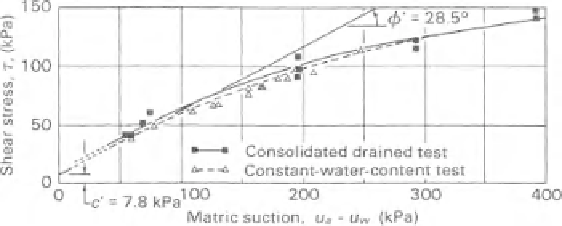Environmental Engineering Reference
In-Depth Information
Figure 11.68
Nonlinearity in matric suction failure envelope for Dhanauri clay compacted to
low density (data from Satija (1978).
Figure 11.69
Nonlinearity in matric suction failure envelope for Dhanauri clay compacted to
high density (data from Satija (1978).
The properties of the coarse kaolin are presented in
Table 11.5. A modified triaxial apparatus similar to the
modified triaxial apparatus described by Fredlund and
Rahardjo (1993a) was used for performing the CW tests.
The specimens were statically compacted in 10 layers
10mm thick. Identical specimens were obtained by com-
pacting kaolin at a maximum dry density of 1
.
35 Mg/m
3
and
an optimum water content of 22%. The height and diameter
of the specimens were 100 and 50 mm, respectively. Three
mini-suction probes (Meilani et al., 2002) were installed
along the length of the triaxial specimen. Details of the
mini-suction probes developed at Nanyang Technological
University, Singapore, were presented in Chapter 4.
The soil specimens were initially saturated in order to
obtain consistent initial water content conditions. Each soil
specimen required about 4 days for the saturation process.
Each specimen required another 3-5 days for matric suc-
tion equalization to a new set of stress conditions. The
specimens were sheared by applying an axial load at a con-
stant strain rate once equilibrium conditions were achieved
under the applied net confining stress
σ
3
−
Table 11.5 Index Properties of Compacted Coarse
Kaolin Specimens
Soil Properties
Value
Specific gravity,
G
s
2.65
Liquid limit, LL (%)
51.0
Plastic limit, PL (%)
35.6
Plastic index, PI (%)
15.4
Silt (%)
85
Clay (%)
15
Unified Soil Classification
System (USCS)
MH (silt of high plasticity)
Maximum dry unit weight,
ρ
d,
max
(Mg/m
3
1.35
)
Optimum water content,
w
opt
(%)
22.0
10
−
8
Saturated coefficient of
permeability for water
phase,
k
s
(m/s)
6
.
4
×
u
a
and matric
suction.
Specimens were tested in the modified triaxial apparatus
under net confining stresses of 25, 50, 100, 150, 200, 250,
300, and 350 kPa with different initial matric suctions (i.e.,
matric suctions of 0, 100, 150, 200, and 300 kPa). A two-
number naming convention was used to designate each CW
triaxial test. The first number was the net confining pressure
in kilopascals while the second number was the initial matric
suction in kilopascals.
Typical CW test results under different net confining
stresses but the same matric suction values of 100 and
200 kPa are shown in Figs. 11.70 and 11.71, respectively.
The experimental results show that at high initial matric
suctions the soil behaves in a manner typical of a
highly overconsolidated soil. The soil specimens exhibit













Search WWH ::

Custom Search